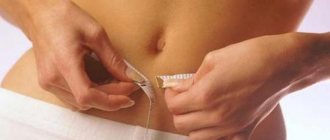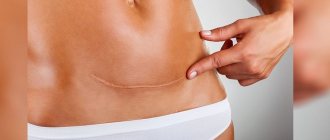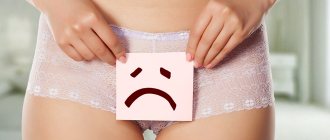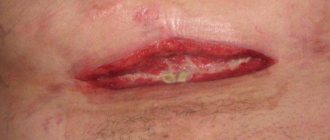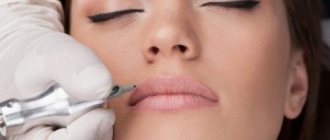First week after abdominoplasty
Physical activity should be limited. In the first week you can walk a little, subsequently increasing the duration of walking. You need to sleep on your back with your head raised, while your legs are bent at the knee joint. To do this, place a couple of pillows under your head. For the first month after abdominoplasty, lift no more than three kilograms. The diet at this time contains a large amount of liquid. Meals 6 times a day. Products that cause gas formation are excluded. If non-absorbable suture material was used, the sutures are removed after 10-14 days. Compression garments are worn without taking them off.
Water treatments after surgery
Patients are advised not to take a bath or use a hot tub, as sitting in standing water may encourage incisions to become infected. Swimming should be avoided while the incisions are healing. Some surgeons allow patients to shower 2-3 days after surgery. It is recommended not to remove compression garments or take a shower under a light stream of water. The medications may cause patients to feel dizzy or unsteady in their legs, so caution must be exercised in the shower. Patients can ask someone to help them or simply stay in the bathroom during the procedure.
Months after abdominoplasty
The regime is gradually expanding. After consultation with a doctor, light physical exercise is allowed. There is no need to wear compression garments all the time, but you should put them on before physical activity. Thermal procedures (saunas, steam baths) are limited to 2 months. Avoid direct sunlight on the scar area. Sex is permitted, careful, without discomfort.
One year after abdominoplasty, the final result of the intervention is assessed. If the rules and recommendations are followed correctly, the recovery period will pass without complications. You will get a beautiful belly that you will admire for the rest of your life. In the absence of weight gain or pregnancy, the effect will remain forever.
Why are compression garments so important?
During surgery, tissues and blood vessels are injured. After injury, fluid from the vessels and capillaries penetrates the tissue. This can interfere with proper healing by allowing fluid to accumulate, which in turn can lead to inflammation, infection, and dehiscence of the wound. During a tummy tuck, a large amount of fat and skin is lifted, creating potential space for fluid to accumulate.
Compression garments after abdominoplasty are used to help reduce swelling, relieve discomfort, and support the tissue while it heals. The underwear is put on immediately after the operation. Once fluids are removed, compression garments prevent bloating by supporting the abdominal wall. Many abdominoplasty patients report pain when not wearing compression garments in the first weeks after surgery.
Recovery from a tummy tuck procedure can take several weeks, and most patients will not see full results until several months after surgery. Wearing compression garments during the early stages of recovery can control swelling and provide comfort to the patient.
Compression garments improve almost every aspect of your recovery.
First, bandages and surgical dressings remain in place, so incisions will be kept clean during the early stages of recovery, thereby reducing the risk of infection. Secondly, pressure is important after abdominoplasty to speed up scar healing. Even pressure has been proven to minimize the likelihood of keloids or hypertrophic scars, improving the scarring process. Abdominoplasty cannot replace diet and exercise. Weight control is an important part of treatment. Compression garments help you maintain your diet by signaling when your abdomen is full while eating.
Atypical situations
- An increase in the volume of the abdominal cavity, tissue compaction, a feeling of transfusion when pressed. Symptoms characteristic of lymph accumulation (seroma). Installation of drainage is required, as suppuration is possible.
- Generalized swelling is a manifestation of kidney or heart dysfunction. Specialist consultation is required.
- The addition of pain and redness in the skin area, tachycardia and fever indicate inflammation of an infectious nature. Treated with a course of antibiotics.
Rehabilitation after abdominoplasty cannot take place without swelling. Knowing the causes, when they occurred and how to combat them will allow you to better control recovery.
How long do swelling and lumps on the abdomen last?
Swelling should increase during the first days after abdominoplasty and then subside. The situation becomes much better after a couple of months, but everything goes away completely only at least six months later.
The process of recovery from edema is very individual. It all depends on the characteristics of the body. For example, for those who have a lot of body fat and thick skin, swelling after abdominoplasty will last longer. So you will have to be patient and follow the instructions of the doctors.
Postoperative actions
The operation itself is performed in a few hours under local anesthesia, after which the patient is sent to a special ward and is under the close attention of doctors for some time.
During the rehabilitation process, different types of compression garments are used. So, both before and after the procedure, it is necessary to wear special stockings - thanks to them, they can reduce the risk of leg thrombosis. The period of wearing such products during recovery is about 5 days.
A belly bandage speeds up the healing of the suture and prevents its dehiscence. The underwear has a comfortable cut, thanks to which it is possible to carry out antibacterial therapy and periodically change dressings without much difficulty.
Complications: when to see a doctor
From a medical point of view, swelling after abdominoplasty and liposuction, as after any other plastic surgery, is not considered a complication. Unfortunately, it is impossible to avoid swelling in the event of surgery. But even this natural postoperative condition nevertheless requires close attention and observation. Situations that require an immediate visit to your surgeon or any qualified physician:
- unnaturally enlarged abdomen,
- tissue hardness and tension,
- sensation of “irridescent” liquid upon palpation,
- increase in body temperature,
- painful sensations,
- change in skin color in the injured area,
- swelling extends far beyond the boundaries of the operated area.
If one or more complaints from the list appear, you should seek medical help as soon as possible. Excessive belly button swelling after abdominoplasty, fluid accumulation, or an enlarged abdomen may be a sign of seroma. If the fluid is not pumped out in time, suppuration may develop.
Pain, redness of the skin, and fever may be a sign of infection that requires treatment with antibiotics. The most serious complication is problems with the functioning of the kidneys and heart, as indicated by swelling beyond the boundaries of the operated area.
Photo
The photo shows what the abdomen looks like before surgery and after plastic surgery.
From special publications on our website you will learn in what cases tummy tuck is performed and what types of operations are performed for those who have recently given birth, as well as what mini-abdominoplasty is.
Benefits of compression garments
- Reduced bruising and swelling
Most abdominoplasty patients experience significant swelling in the abdomen and groin area. Water retention and swollen tissue can be quite uncomfortable.
Compression garments can prevent the development of tissue swelling.
Physical pressure helps shift the fluid balance in the body to stimulate absorption. Pressure helps “push” fluid out of the tissues. This results in faster resolution of the bruising and swelling common after abdominoplasty. The first two weeks are very important; in the next two weeks, clothing may be removed during rest periods.
- Improves blood circulation and reduces the risk of complications
Compression has long been used to improve circulation after injury and is an important factor in healing. After surgery, there is always a risk of fluid accumulation at the surgical site, which may result in the formation of hematomas, seromas, or lymphedema. The compression provided by the compression garment will encourage the passage of fluid, thereby reducing the risk of blockage and accumulation.
- Bringing the skin into line with the new contours of the abdomen
Wearing compression garments during the recovery period can help maintain the new contours of the abdomen by keeping the skin and tissue in position during the healing process so that the body can easily maintain its new shape. There is always a small chance of uneven healing of the skin over injured tissue. Compression garments apply uniform pressure over an area, improve skin adhesion to tissue, and also help the skin conform to the new contours of the body.
- Reduced discomfort
Compressing the surgical area minimizes movement of damaged tissue, helping patients experience discomfort while resting or moving. Taking care of yourself on a daily basis can be challenging in the weeks following your abdominoplasty. Wearing clothing with the proper level of compression can provide greater freedom of movement. For many patients, clothing can also encourage healthy posture and reduce pain or discomfort while sitting or standing.
How long should I wear compression clothing?
Surgeons require this garment to be worn around the clock for the first two weeks after surgery.
Wearing compression garments is very important for the final surgical outcome.
Many surgeons recommend wearing compression garments 24 hours a day for the first 2 to 3 weeks. It depends on the invasiveness of the procedure and the type of underwear. In general, patients can expect to wear compression garments for 4-6 weeks after surgery, depending on the specifics of the individual case. Then you should switch to a smaller clothing size, or clothing with less compression. If the muscles have not undergone “repair”, then, as a rule, wearing underwear for three weeks is sufficient.
Surgeons note that many patients continue to wear compression garments after the recommended period. They find that the extra support helps them feel more comfortable doing normal activities.
